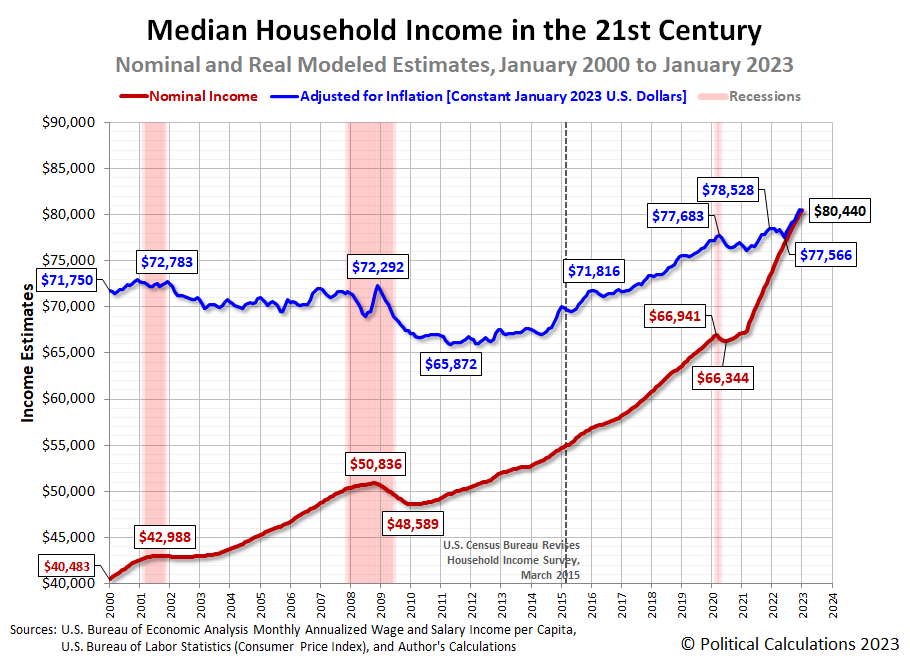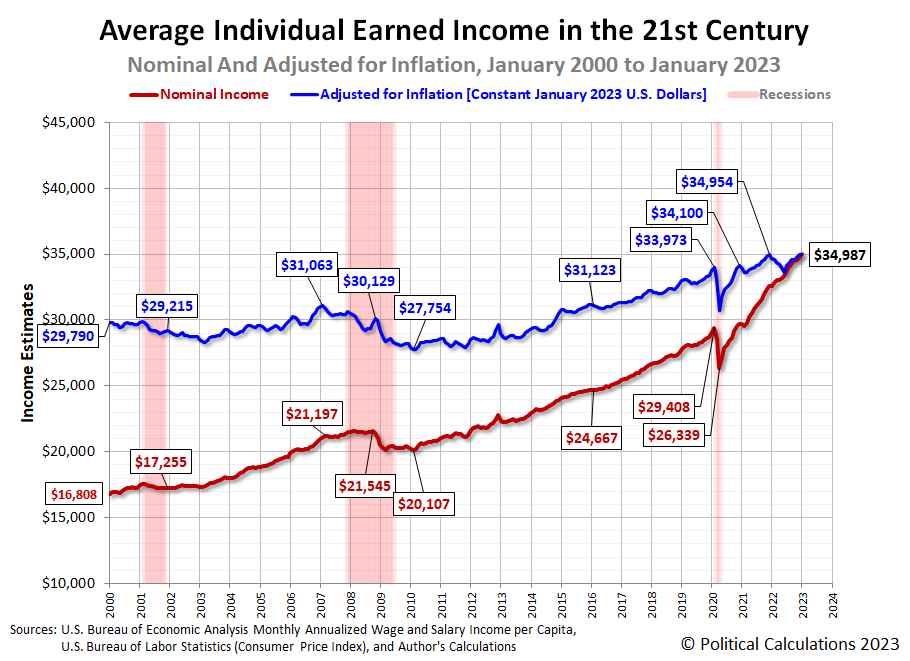Political Calculations' initial estimate of median household income in January 2023 is $80,440, an increase of $1,035 (or 1.3%) from the initial estimate of $79,405 in December 2022.
Update 31 October 2023: We have revised our estimate of median household income for this month based on new information from the U.S. Census Bureau for 2022 and revisions to income data by the Bureau of Economic Analysis that were released in September 2023. Please follow this link to see how much. If you're interested, we've provided more information about what has changed and why we think its significant.
That's a substantial increase, but over half of the positive change we're reporting is the result of the Bureau of Economic Analysis' upward adjustments of aggregate income data earned in each month during the second half of 2022. For reference, the revised nominal estimate for December 2022 is $79,939, which accounts for $534 (or 51.6%) of the change from our original estimate.
These changes are incorporated in the latest update to Political Calculations' chart tracking Median Household Income in the 21st Century reflects the results of that revision, showing the nominal (red) and inflation-adjusted (blue) trends for median household income in the United States from January 2000 through January. The inflation-adjusted figures are presented in terms of constant January 2023 U.S. dollars.
Adjusted for inflation, December 2022's estimated median household income still represents a new record peak for this demographic characteristic, with real median household income falling because of a surge in January 2023's reported level of inflation.
The data revisions also affect the estimate of average personal income. At $34,987, January 2023's nominal median household income represents a new record high for this measure, which also exceeds its previous inflation-adjusted peak from December 2021.
This month's aggregate income revisions follow last month's substantial upward revisions of U.S. population estimates. Those revisions had effectively lowered our estimates of median household income and average personal earned income. This month's significant upward income revisions from July through December 2022 reverse much of that effect.
Analyst's Notes
We can most easily see the net impact all these revisions by comparing the updated nominal average personal income estimate for November 2022 with our original estimate for this month, prior to the population and aggregate income revisions. Our original estimate of November 2022's average personal earned income was $34,231, our revised estimate is $34,563, an increase of $332 (or +0.1%).
That small result compared to the large change we're seeing for January 2023's estimate suggests a significant acceleration for American income growth in the new year. Following the substantial data revisions we've seen during the past two months, we anticipate much smaller revisions for both population and aggregate income in the months ahead.
For the latest in our coverage of median household income in the United States, follow this link!
References
U.S. Bureau of Economic Analysis. Table 2.6. Personal Income and Its Disposition, Monthly, Personal Income and Outlays, Not Seasonally Adjusted, Monthly, Middle of Month. Population. [Online Database (via Federal Reserve Economic Data)]. Last Updated: 24 February 2023. Accessed: 24 February 2023.
U.S. Bureau of Economic Analysis. Table 2.6. Personal Income and Its Disposition, Monthly, Personal Income and Outlays, Not Seasonally Adjusted, Monthly, Middle of Month. Compensation of Employees, Received: Wage and Salary Disbursements. [Online Database (via Federal Reserve Economic Data)]. Last Updated: 24 February 2023. Accessed: 24 February 2023.
U.S. Department of Labor Bureau of Labor Statistics. Consumer Price Index, All Urban Consumers - (CPI-U), U.S. City Average, All Items, 1982-84=100. [Online Database (via Federal Reserve Economic Data)]. Last Updated: 14 February 2023. Accessed: 14 February 2023.
Image credit: Photo by Kostiantyn Li on Unsplash.
Labels: median household income
Welcome to the blogosphere's toolchest! Here, unlike other blogs dedicated to analyzing current events, we create easy-to-use, simple tools to do the math related to them so you can get in on the action too! If you would like to learn more about these tools, or if you would like to contribute ideas to develop for this blog, please e-mail us at:
ironman at politicalcalculations
Thanks in advance!
Closing values for previous trading day.
This site is primarily powered by:
CSS Validation
RSS Site Feed
JavaScript
The tools on this site are built using JavaScript. If you would like to learn more, one of the best free resources on the web is available at W3Schools.com.


